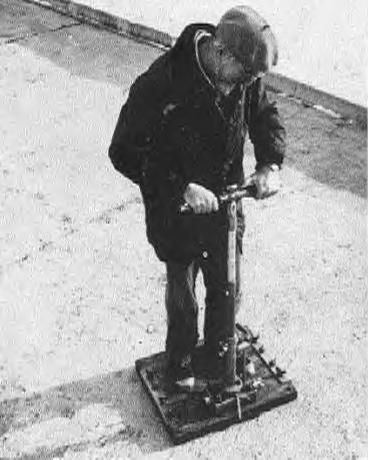Fourth in This Levitation Series
Discovering natures way for efficient transportation

photo credit: pexels, Sebastian
There’s been a lot of speculation about Viktor Grebennikov’s levitating device. Only a few photos of its operation can be found in circulation. One of the photos, when enlarged, shows the face of its operator to be blanked out. There are no design plans, no schematics. To make the claim that a device can levitate without a source of fuel is interpreted by the sceptics as malarkey. Without evidence, conjecture is irrelevant. It is therefore, mandatory to produce operational validation.
Cavity Structures Effect
Can the cavity structures of the Cavity Structures Effect (CSE) produce a levitating reaction from the atmosphere or Earth’s magnetic field? The conjecture regarding the legitimacy of Grebennikov’s might be in question, however, the CSE has been shown to be accurate.
An excerpt pointed out in the article from aetherforce.energy:
"There have been many hypotheses about the physical nature of the CSE, but there is one theory that deserves greater attention. It was developed earlier by Valery F. Zolotariov (1931-2000), Doctor of Physical and Mathematical Sciences, and it is now experimentally confirmed. (1, 3)
As a result of a long collaborative research Grebennikov and Zolotariov (1987) describe the discovery as “previously unknown phenomena of interaction between multi cavity structures and living systems, in which de Broglie waves associated with motion of electron flows in the solid walls of cavities create, by interference, a macroscopic field of multi cavity structures, which causes changes in the functional state of living objects located in this field”. (1, 3)
In multi cavity structures, where the surface area is repeatedly curved, the super high frequency de Broglie waves are added together and they form, like musical overtones, harmonics with lower frequencies. Thus, by lengthening and strengthening due to the mutual overlap in the cells, they form anti-node maximums of standing de Broglie waves. Running against these passive obstacles, nerve impulses change their frequency and speed, causing not only the apparent sensations, but sometimes also significant physiological changes. (1, 3)"
Levitation is vibrational action. With Earth’s magnetic field, in conjunction with the electromagnetic fields in the atmosphere, it can be theorized there is possible legitimacy to Grebennikov’s device.
Reconstruction of this design to test its effectiveness is imperative.
One of the insightful physicists of the 20th century was Richard Feynman. Listed on the Caltech.edu site are some of his lectures. His lecture on the electricity in the atmosphere: The electric potential gradient of the atmosphere, is particularly relevant in discovering ways to enable Grebennikov’s levitating device. His lecture begins by pointing out: On an ordinary day over flat desert country, or over the sea, as one goes upward from the surface of the ground the electric potential increases by about 100 volts per meter. Thus, there is a vertical electric field E of 100 volts/m in the air. The sign of the field corresponds to a negative charge on the earth’s surface.
Further, Feynman shows the way to measure this gradient.
There is another way to directly measure the potential gradient. Since there is an electric field, there is a surface charge on the earth (σ=ϵ0E). If we place a flat metal plate at the earth’s surface and ground it, negative charges appear on it (Fig. 9–2a). If this plate is now covered by another grounded conducting cover B, the charges will appear on the cover, and there will be no charges on the original plate A. If we measure the charge that flows from plate A to the ground (by, say, a galvanometer in the grounding wire) as we cover it, we can find the surface charge density that was there, and therefore also find the electric field.
Having suggested how we can measure the electric field in the atmosphere, we now continue our description of it. Measurements show, first of all, that the field continues to exist, but gets weaker, as one goes up to high altitudes. By about 50 kilometers, the field is very small, so most of the potential change (the integral of E) is at lower altitudes. The total potential difference from the surface of the earth to the top of the atmosphere is about 400,000 volts.
In his lectures, he also discusses the activity of ions in the atmosphere. Excerpts are included, as an important consideration when researching ways to enable levitation.
Electric currents in the atmosphere
Another thing that can be measured, in addition to the potential gradient, is the current in the atmosphere. The current density is small—about 10 microamperes crosses each square meter parallel to the earth. The air is evidently not a perfect insulator, and because of this conductivity, a small current—caused by the electric field we have just been describing—passes from the sky down to the earth.
Why does the atmosphere have conductivity? Here and there among the air molecules, there is an ion—a molecule of oxygen, say, which has acquired an extra electron, or perhaps lost one. These ions do not stay as single molecules; because of their electric field they usually accumulate a few other molecules around them. Each ion then becomes a little lump which, along with other lumps, drifts in the field—moving slowly upward or downward—making the observed current. Where do the ions come from? It was first guessed that the ions were produced by the radioactivity of the earth. (It was known that the radiation from radioactive materials would make air conducting by ionizing the air molecules.) Particles like β-rays coming out of the atomic nuclei are moving so fast that they tear electrons from the atoms, leaving ions behind. This would imply, of course, that if we were to go to higher altitudes, we should find less ionization, because the radioactivity is all in the dirt on the ground—in the traces of radium, uranium, potassium, etc.
The purpose for quoting so much of Feynman’s work is to clarify and validate the potential in utilizing Earth’s magnificent volume of available electric and magnetic fields.
Again, analyzing Grebennikov’s device; its simplicity is based on the principles of nature.

Grebennikov’s written work speaks of it being made of an art box. It’s also specified to be made of four fans. The fans are what Grebennikov refers to as “blinds”. The CSEs are intensified by compression. It’s surmised that replicating Grebennikov’s device, requires several layers of CSEs.
The blogpost, Using Air for Levitation, provides an excerpt from pdfcoffee.com:
Two bolt heads can also be seen on the photographs, approximately in the center of each platform halves. This is a bonding of the distribution mechanism, which transfers effort from the “distributors” to a fan opening device. Each fan consists of nine plates. In order to make them strong, the plates are made of sheet metal. Micro-nets are stuck from the upper surface of each plate. On the one hand, the metal does not prevent nets from operating because the effect of cavitary structures cannot be screened and, on the other hand, protects them from mechanical influences such as influence of grass during landing. Holes in the plates, which can be seen, are not related to micro-cells. They are made only for lightening the metal plates’ weight. Do you see that it is difficult for Grebennikov to hold even a lightened version of his platform?
Antigravity effect (created due to the effect of cavitary structures) is produced by the cells but they need “fuel” in order to work with maximal efficiency.
This ‘fuel’ is speculated to be the interaction of CSEs with Earth’s magnetic field and the current in Earth’s atmospheric electric potential fields.
Conclusion
Theories are great for conversation and provide the foundation of research. A problem with think-tanks and theories is they operate as consultant organizations without the ability for hands-on building research. Beyond theory is proof; evidence through design implementation. The only way to test the legitimacy of Grebennikov’s device is to build it. Several of the previous blogposts provide most of the pieces for how Grebennikov’s device can be rebuilt.
The blogpost: Chitin and Grits, Grebennikov lists many ways to achieve CSEs.
Short Distance Designs asks a question to skeptics who that claim a passive design can’t be used for transportation. Would they deny that skiing, hang gliding, sailing, or surfing is also impossible?
Crystals and Polymers provides possibilities for replicating CSEs, as well as other pertinent details.
Bug Wings for Travel asks the question: can CSEs be manufactured to produce the CSEs needed to support Grebennikov’s device technology?
There are many other blogposts with supporting analysis of Earth’s magnetic core and its atmosphere, which lead to the possibility of validity of Grebennikov’s levitating device.



